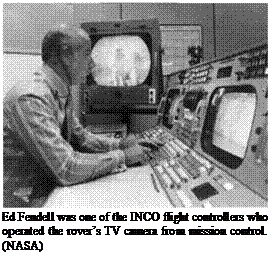Outside broadcast
Among the most remarkable items to be mounted on the rover were those associated with communication, at the centre of which was the lunar communications relay unit (LCRU). This went on the very front of the vehicle between a mast for the TV camera and another for an umbrella-type dish antenna. These turned what was already a uniquely capable vehicle into the most outlandish television outside broadcast unit ever seen.
The LCRU had a number of important functions. It acted as a relay for voice communication between the two crewmen on the surface and Houston, and it passed biomedical telemetry to the Surgeon. It sent telemetry about the state of the astronauts’ back packs and itself to the flight controllers. But its most visible role was to send TV pictures to Earth. It also allowed a flight controller in Houston to remotely operate the camera while the crew got on with their work. An S-band radio link with Earth was provided by either the high-gain dish if TV was to be sent, or a low-gain antenna if only voice and telemetry were required. When the rover halted at a geology station, one of the crew had to manually aim the high-gain antenna before television could be received on Earth and for this, the antenna included a simple sighting arrangement that could be used by a fully suited crewman.
The INCO flight controller in mission control had the job of operating the camera in response to requests by others in the mission control team. In this way, many eyes in Houston could watch what the two crewmen were doing, and it enabled scientists in the mission support room to build up panoramic views of each such site and look
around for interesting rocks for the astronauts to inspect.
 As he prepared the rover for their first traverse, David Scott noticed that the newly installed camera was following his every move. "Gee, you’re watching me flounder around out here.” He later recounted the moment he and frwin realised they were not really alone on the Moon.
As he prepared the rover for their first traverse, David Scott noticed that the newly installed camera was following his every move. "Gee, you’re watching me flounder around out here.” He later recounted the moment he and frwin realised they were not really alone on the Moon.
"You’re suddenly aware of the third person. I remember that, at that moment, I realised for the first time that we were being watched by everybody behind that lens! It was almost like looking through the lens into the control room.”
Although the TV camera used on the rover was among the best flown on Apollo, engineers continued to improve the final picture quality throughout the J-missions. Apollo 15’s camera had no lens hood and as soon as Scott began to drive, significant dust was kicked up by the wheels onto the lens. Then, as INCO panned around their first geology stop, he found that when the Sun caught even a small amount of dust on the lens surface, the scattered light greatly degraded image quality. Though the crew brushed it regularly, even a small amount of residual dust scattered sunlight effectively and affected the picture which required the dust to be brushed off the lens every time they arrived at a new station. A more effective solution had to wait for Apollo 16 with the addition of a lens hood to exclude the Sun whenever possible. For the last two missions of the Apollo programme, further improvements were made by having the TV signals linked to California where a proprietary system enhanced the images before they were returned to Houston for distribution.
The cooling mechanism for the LCRU was similar to that for the batteries in that it used radiators, with a dust cover provided for when the rover was moving. But one interesting difference was that the LCRU contained a quantity of wax that absorbed large amounts of heat as it melted from solid to liquid form. When the covers came off, the heat radiated away and the wax solidified, ready for the next cycle.










